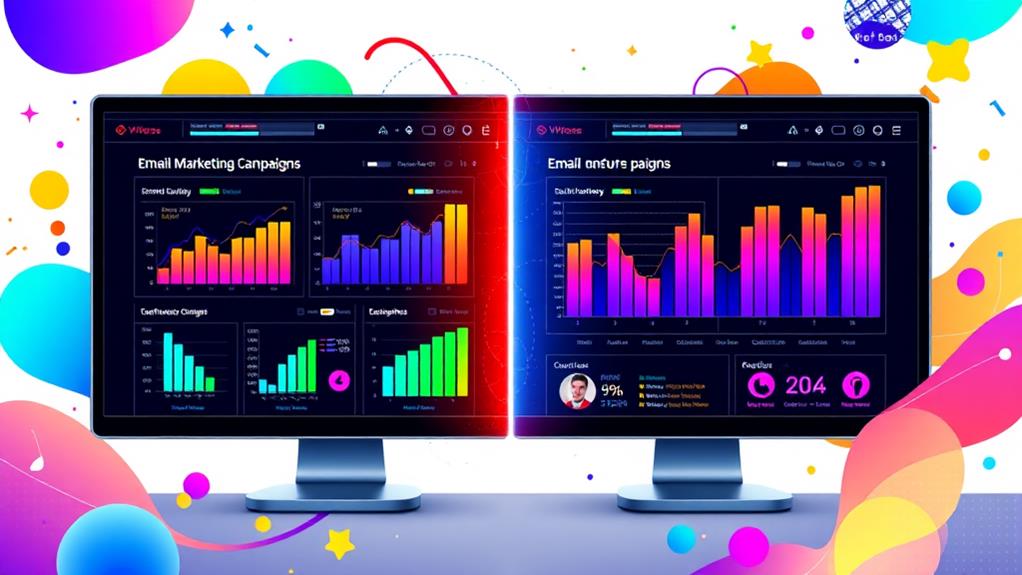In 2024, businesses can greatly boost email open rates by employing advanced segmentation tactics that integrate AI-driven dynamic segmentation and predictive analytics. These methods personalize content delivery based on real-time user behavior, leading to a potential 20% increase in open rates. Crafting personalized subject lines using recipient names and emotion-driven language can further enhance open rates by 22%. Real-time behavioral data and highly personalized content are key, with predictive analytics improving customer engagement and fostering retention. Targeted email campaigns based on these strategies can drive substantial increases in revenue and consumer connection, offering deeper insights into customer interaction dynamics.
Key Takeaways
- Leverage AI algorithms to analyze user behavior for precise email segmentation and enhanced targeting.
- Use predictive analytics to anticipate customer needs, leading to personalized content and higher engagement.
- Implement personalized subject lines with recipient names to boost open rates by 22%.
- Utilize real-time behavioral data for tailored messaging, increasing click-through rates by 25%.
- Conduct A/B testing on subject lines to identify styles that optimize open rates.
Leveraging AI for Dynamic Segmentation
In today's data-rich marketing landscape, AI's transformative power in dynamic segmentation is revolutionizing how marketers connect with their audiences. By leveraging AI algorithms, marketers can analyze real-time user behavior and preferences to create highly targeted email segments. This approach guarantees that communications are not only relevant but also adaptable to the evolving nature of customer interactions.
The strategic use of AI-driven tools enables the processing of large data volumes swiftly, uncovering patterns in customer behavior that inform segmentation strategies, ultimately leading to improved engagement rates.
The integration of machine learning algorithms automates the segmentation process, greatly reducing manual effort while maintaining accuracy in audience targeting. This automation guarantees that email lists remain up-to-date with the latest customer activity, making the content delivered more pertinent to individual recipient interests.
Implementing AI for dynamic segmentation has shown a remarkable increase in open rates, by up to 20%, further underscoring the effectiveness of personalized content delivery.
Moreover, advanced AI segmentation techniques bolster predictive analytics capabilities, allowing marketers to anticipate customer needs. By tailoring messaging to meet these anticipated needs, businesses can drive higher engagement and conversion rates, establishing deeper customer connections.
Personalization Strategies for Open Rates
Enhancing open rates through personalization strategies is an essential component in the arsenal of modern email marketing. Personalized emails can boost open rates by an impressive 82%, underscoring the power of aligning content with customer preferences. By incorporating demographic insights, marketers can tailor emails to resonate with specific audience segments, greatly increasing engagement.
For instance, including the recipient's name in the subject line can lead to a 22% uplift in open rates, showcasing the effectiveness of this straightforward personalization tactic.
Furthermore, emotive language in subject lines, such as "Exclusive Offer Just for You," taps into the psychological triggers of consumers, enhancing open rates by fostering a sense of exclusivity and urgency. Such strategies are not only effective in initial engagement but also play a key role in fostering brand loyalty.
McKinsey reports that consumers are 76% more likely to repurchase from brands offering personalized communication, emphasizing the long-term value of personalization.
Additionally, A/B testing personalized subject lines and content can further optimize email campaigns. Segmented campaigns have shown a remarkable 760% increase in email revenue, demonstrating the tangible benefits of leveraging customer preferences and demographic insights to refine personalization strategies.
Crafting Targeted Subject Lines
Crafting targeted subject lines is a strategic necessity in email marketing, greatly influencing open rates and engagement. Personalized subject lines can yield a 22% increase in open rates, emphasizing the value of directly addressing recipients. Emotion driven phrasing can captivate attention by evoking emotional responses, enhancing the likelihood of emails being opened. Similarly, urgency driven tactics, such as "Limited Time Offer," can compel immediate action, markedly boosting open rates.
| Strategy | Impact on Open Rates | Key Element |
|---|---|---|
| Personalization | +22% | Address recipients directly |
| Emotion Driven Phrasing | Increases appeal | Evokes emotional response |
| Urgency Driven Tactics | Boosts immediacy | Promotes immediate action |
| A/B Testing | Optimizes performance | Identifies effective styles |
| Clarity and Conciseness | Prevents confusion | Guarantees clear communication |
A/B testing remains essential, allowing marketers to discern which phrases and styles resonate most. This iterative approach refines strategies, guaranteeing high performance. Furthermore, clear and concise subject lines are vital; they prevent confusion, making emails' purposes immediately apparent, thereby enhancing open rates.
Real-Time Behavioral Data Utilization
While crafting targeted subject lines is a foundational strategy to enhance email open rates, leveraging real-time behavioral data takes email marketing to a more personalized and impactful level. By analyzing user behavior, marketers can dynamically segment their audience to deliver highly relevant content. This approach, as demonstrated by e-commerce giants like Amazon, has shown to boost click-through rates by 25%, illustrating the power of tailoring messages to real-time interactions.
Real-time data utilization involves monitoring engagement metrics such as website visits, product views, and cart abandonments. This continuous data flow enables timely reminders and personalized offers, directly addressing user interests and increasing the likelihood of conversions. For example, sending an abandoned cart email shortly after a user leaves their cart has proven to greatly uplift conversion rates.
Moreover, engaging subscribers based on their immediate actions not only optimizes open rates but also enhances overall user experience. Targeted emails, crafted from real-time insights, can yield up to 39% higher open rates compared to their generic counterparts.
Automated data analytics further refines this process, identifying user behavior patterns that align with customer preferences, thereby enabling marketers to create campaigns that resonate deeply with their audience.
Predictive Analytics in Email Campaigns
Employing predictive analytics in email campaigns represents a strategic leap forward in personalized marketing efforts. By harnessing predictive modeling, marketers can leverage historical data and advanced machine learning algorithms to anticipate customer behavior with remarkable accuracy. This foresight enables the crafting of highly personalized email content that resonates with individual recipients, thereby increasing engagement and open rates by up to 20%.
Predictive analytics explores deep into customer insights, analyzing patterns in user engagement and preferences to identify segments most likely to respond positively. This precision targeting not only enhances the effectiveness of email campaigns but also fosters stronger customer relationships. According to studies, businesses incorporating predictive analytics into their strategies witness a remarkable 15% uptick in customer retention, underscoring the value of timely, relevant communications.
Moreover, predictive analytics tools automate the segmentation process, dynamically updating lists based on real-time data. This automation guarantees that marketing efforts remain agile and responsive to changing consumer behaviors, optimizing campaign effectiveness.
Frequently Asked Questions
How Does Email Segmentation Impact Overall Marketing Strategy in 2024?
Email segmentation greatly enhances overall marketing strategy in 2024 by utilizing personalization techniques to tailor content, thereby aligning with audience behavior. This strategic approach increases engagement and drives conversion, resulting in a more effective and data-driven marketing outcome.
What Tools Are Recommended for Managing Large-Scale Segmented Email Lists?
Effective email list management for segmentation requires robust tools like Mailchimp, HubSpot, and Klaviyo. These platforms offer strategic insights, enabling marketers to analyze data and optimize campaigns, enhancing engagement through targeted communication with large-scale segmented email lists.
How Can Marketers Measure the Success of Segmented Email Campaigns?
Marketers can measure the success of segmented email campaigns by analyzing performance metrics such as open rates, click-through rates, and conversion rates. Monitoring engagement rates provides strategic insights into audience preferences and informs future campaign optimizations.
What Are Common Mistakes to Avoid in Advanced Email Segmentation?
Common segmentation pitfalls include over-segmenting, which dilutes messaging, and audience misconceptions, where incorrect data leads to ineffective targeting. Strategically leveraging accurate data guarantees segments are meaningful, enhancing engagement and driving measurable results in email campaigns.
How Can Small Businesses Implement Advanced Email Segmentation Tactics Effectively?
Small businesses can implement advanced email segmentation effectively by analyzing customer behavior to identify distinct segments. Tailoring content to the target audience based on these insights enhances engagement, thereby driving higher open rates and fostering customer loyalty.
Conclusion
Incorporating advanced segmentation tactics in email marketing can greatly enhance open rates by leveraging AI for dynamic audience segmentation, employing personalization strategies, and crafting targeted subject lines. Utilizing real-time behavioral data and predictive analytics further refines campaign effectiveness, enabling marketers to anticipate recipient needs and preferences. These data-driven approaches underscore a strategic shift towards more insightful and responsive email marketing practices, promising improved engagement and higher conversion rates in the evolving digital landscape of 2024.




